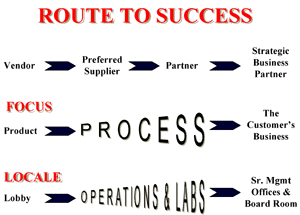by Charles Smith
Moving from the traditional customer-vendor sales model and into global account management (GAM) with a designated key customer explicitly connotes that a strong, working relationship is to be developed with this customer -- and that you believe it is likely to be successful based on parameters for success which you have developed. A relationship may already exist at some level. But committing to moving into GAM is a commitment to doing what's required to take a large and growing share of a strategic customer's business through the foreseeable future. It connotes a commitment to extend the relationship through all levels of your company and the customer's company. Not only must the business relationship function easily and smoothly at the operations and engineering levels, but a synergy must positively evolve at the executive level and on into the "Board Room".  At the strategic business associate (SBA) level relationship, long-term "co-planning" reflects the positive corporate "co-dependency" which can and should serve as a lock-out to all but the most trivial competitive participation with this strategic customer. The resulting long-term orderly growth in revenues and profits should improve for both of the strategic business associates, the customer and the supplier.
At the strategic business associate (SBA) level relationship, long-term "co-planning" reflects the positive corporate "co-dependency" which can and should serve as a lock-out to all but the most trivial competitive participation with this strategic customer. The resulting long-term orderly growth in revenues and profits should improve for both of the strategic business associates, the customer and the supplier.
Moving along the relationship "route to success" (See figure 1) and the achievement of this type of constructive, mutually advantageous, "insider" relationship is the entire reason for the commitment of effort, resources and time to achievement of the strategic business associate's or true insider's position with a strategic customer. In this three-part article, we address some elements of business-to-business relationships -- identifying their potential, selecting the right ones and sustaining those selected to become SBAs.
EVERYTHING WE DO IN MANAGING THE GAM TEAM IS IN THE CONTEXT OF THE RELATIONSHIP DYNAMICS!
Effective business-to-business relationships don't just happen (at least not very often). The successful ones have been carefully selected, generally by the supplier company, after a serious evaluation. Relationships EVOLVE! They go through a series of stages from a straight vendor relationship through becoming a preferred supplier to the most often final stage of a relationship -- partner. Most relationships in the semiconductor equipment and materials (SEM) industry stop at the partner stage, not because there isn't a higher level of effectiveness to be achieved in a business relationship, but because one or both parties to the potential "next step" are unable to "open the kimono" and allow a true strategic association to ensue. The reasons for the hesitation at this stage are many. At the partner stage of the relationship and beyond, the supplier company necessarily becomes more concerned with elements of the customer's business as he must in order to be effective for both partners. The principals to the relationship may simply be unable to "color outside the lines", to redefine the relationship to include shared long-term planning involving corporate "secrets" on both sides and the acceptance of the fact of true interdependence. The old paradigms too often govern; the concept of the account manager as "just a sales person" is often still locked firmly in place. Hence the evolution of GAM; to further the effectiveness of this necessary interdependence
In the course of reaching "partner status", suppliers of SEM products modify their purely product focus to varying degrees of process and applications, that is, making their product or service perform virtually perfectly in the customer's facility and with the customer's personnel. The site of the sales action moves from the various lobbies at customer facilities into engineering and manufacturing offices, laboratories and onto the manufacturing floor (after signing the necessary NDAs and other security documents).
At this point many SEM companies think, "We've made it! We have a partnership!" Sadly they realize only how far they've come (and it's not unimpressive!). They don't realize how far they have yet to travel along the relationship route (see Fig. 1) to achieve true strategic business associate status, the status which builds the supplier into the customer's long-term plans and strategies which can't really be successfully developed or executed by the customer without the critical supplier's contribution.
In part 2 of this series, we'll discuss the initial analysis and selection of our intended strategic business associates as well as analysis of our own supplier company in order to set up relationship success.

|
